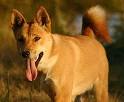The more I see of humans,
The more I love Dogs
Wild Dogs : DINGO OF AUSTRALIA
Captain William Dampier, one of the first people to set his foot on Australian soil in 1688 wrote,' My men spied two or three wolf - like creatures. They were starving hungry, and skeletal to the point where they looked like skin and bones.' What Captain William and his men saw was the Australian DINGO, the only original non-marsupial mammal of the continent.
When early Europeans arrived with their livestock, the ravenous dingoes attacked the flocks with such zeal that for centuries they became the shepherd's main enemy. From the very outset, the dingoes showed no fear towards domestic dogs, and behaved with them as if they were kith and kin.
The dingo lives in small groups of five or six individuals belonging to a single family; in rare cases these packs may number up to a hundred animals. Australian aborigines keep them for hunting purposes, each tribe having a couple of them.
The cubs can be found in the hollows of trees and are reared with a great deal of loving care. The Aborigines let the dingoes sleep in their huts, and feed them with fish and meat.
Dingoes act timidly towards people, which is why the Aborigines never punish them; at worst they will simply scold them while they are hunting.
The dingo will mate with the dog and the offsprings are fertile. When they were mated with the English Sheep-dog or Scottish Collie, the outcome developed into the KELPIE, the highly intelligent Australian sheep-dog.
Like all the wild dogs, the dingo does not bark. The dingo is smaller and lighter than the wolf. The colour varies from tawny to straw to black. The feet and the tip of the tail are invariably white .

Raj Prateek Verma
Wild Dogs : DINGO OF AUSTRALIA
Captain William Dampier, one of the first people to set his foot on Australian soil in 1688 wrote,' My men spied two or three wolf - like creatures. They were starving hungry, and skeletal to the point where they looked like skin and bones.' What Captain William and his men saw was the Australian DINGO, the only original non-marsupial mammal of the continent.
When early Europeans arrived with their livestock, the ravenous dingoes attacked the flocks with such zeal that for centuries they became the shepherd's main enemy. From the very outset, the dingoes showed no fear towards domestic dogs, and behaved with them as if they were kith and kin.
The dingo lives in small groups of five or six individuals belonging to a single family; in rare cases these packs may number up to a hundred animals. Australian aborigines keep them for hunting purposes, each tribe having a couple of them.
The cubs can be found in the hollows of trees and are reared with a great deal of loving care. The Aborigines let the dingoes sleep in their huts, and feed them with fish and meat.
Dingoes act timidly towards people, which is why the Aborigines never punish them; at worst they will simply scold them while they are hunting.
The dingo will mate with the dog and the offsprings are fertile. When they were mated with the English Sheep-dog or Scottish Collie, the outcome developed into the KELPIE, the highly intelligent Australian sheep-dog.
Like all the wild dogs, the dingo does not bark. The dingo is smaller and lighter than the wolf. The colour varies from tawny to straw to black. The feet and the tip of the tail are invariably white .
Raj Prateek Verma








